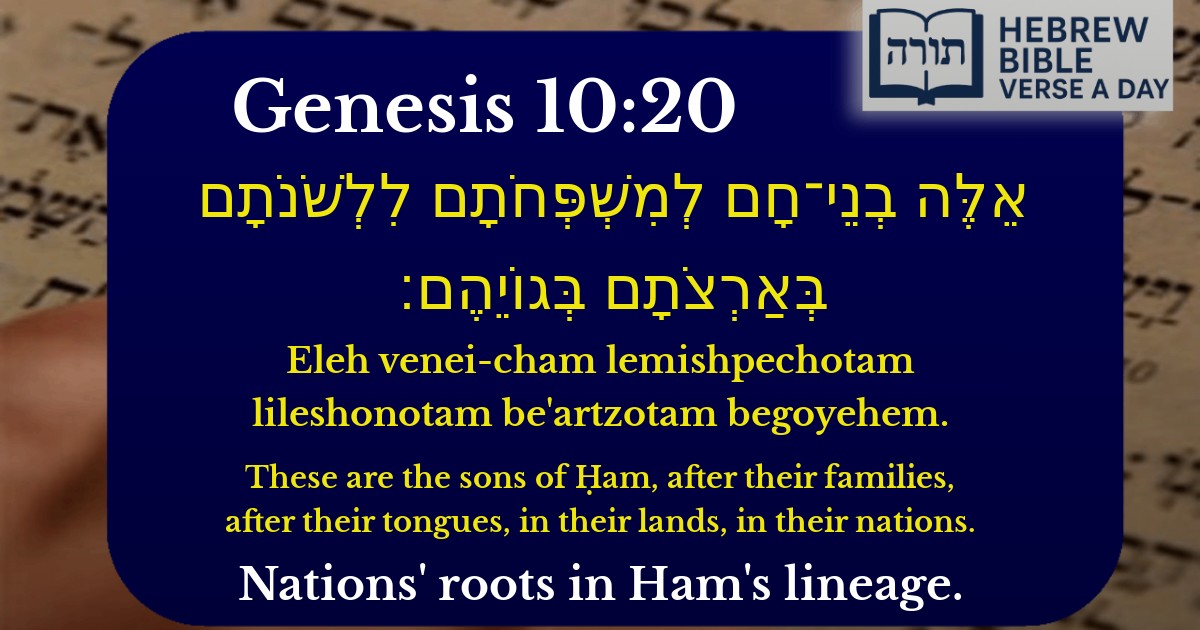Frequently Asked Questions
Q: What does Genesis 10:20 mean?
A: Genesis 10:20 lists the descendants of Ḥam (one of Noaḥ's sons) by their families, languages, lands, and nations. This verse is part of the 'Table of Nations,' which traces how humanity spread after the Flood. According to Rashi, this shows how all nations branched out from Noaḥ's family, each with its own unique identity.
Q: Why is the genealogy of Ḥam important in the Torah?
A: The genealogy of Ḥam is important because it establishes the origins of many nations, some of which later interact with the Jewish people (like Egypt and Canaan). The Ramban explains that these details help us understand historical relationships and fulfillments of prophecies, such as the curse on Canaan (Genesis 9:25).
Q: What can we learn from the phrase 'after their tongues, in their lands, in their nations'?
A: This phrase teaches that diversity in language, territory, and nationality is part of Hashem's plan for humanity. The Midrash (Bereshit Rabbah) explains that after the Tower of Babel (Genesis 11), languages and nations became distinct, showing that unity must be based on serving G-d, not human arrogance.
Q: How does Genesis 10:20 apply to Jewish identity today?
A: This verse reminds us that Jewish identity is tied to family (מִשְׁפָּחָה), language (Hebrew), land (Israel), and nationhood (Am Yisrael). The Sforno notes that just as Ḥam's descendants had distinct identities, the Jewish people must preserve their unique heritage while living among other nations.


Context in Sefer Bereishit
The verse (Bereishit 10:20) concludes the enumeration of the descendants of Ḥam, one of Noaḥ's three sons, following the narrative of the Mabul (Flood). This section, known as the "Toldot Bnei Noaḥ" (Generations of Noaḥ's Sons), outlines the origins of the nations and their dispersion across the earth.
Rashi's Commentary
Rashi (Bereishit 10:20) emphasizes the phrase "לְמִשְׁפְּחֹתָם לִלְשֹׁנֹתָם" ("after their families, after their tongues"), noting that this establishes the division of nations by both lineage and language. He connects this to the earlier dispersion at Migdal Bavel (Tower of Babel), where Hashem confounded human speech (Bereishit 11:9). Thus, the verse underscores Divine Providence in shaping nations through distinct identities.
Rambam's Perspective
In Moreh Nevuchim (1:7), Rambam discusses how language and geography shape cultural and spiritual development. The phrase "בְּאַרְצֹתָם בְּגוֹיֵהֶם" ("in their lands, in their nations") reflects the idea that each nation’s unique environment influences its character—a theme later expanded in discussions of the seventy nations and their roles in creation.
Midrashic Insights
Halachic Implications
The Ramban (Bereishit 10:20) notes that these divisions form the basis for the Torah’s later distinctions between nations (e.g., the seven Canaanite tribes). The Sefer HaChinuch (Mitzvah 425) further ties this to the prohibition against imitating gentile customs, as each nation’s unique path reflects Divine will.